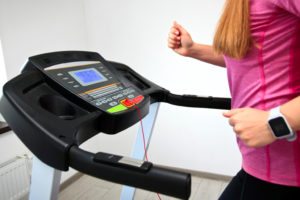
Between diminishing daylight and slippery sidewalks, it’s tempting to think that the right home exercise machine will keep us fit all through the gloomy season.
If only.
“It’s easy to go out and spend thousands of dollars on equipment, but often, it just sits and collects dust,” said Jodi George, DPT, a physical therapist with Spectrum Health.
Just as many gym memberships go unused, impulsively purchased exercise equipment may be enjoyable for a few weeks, then turn tedious. It’s worth noting the treadmill was invented as a way to punish prisoners in the 19th century.
Buying the wrong machine doesn’t just waste money. Staring at an unused piece of machinery every time you walk into the bedroom is discouraging.
“It can be demoralizing to see it, and make you feel like you’ve failed when it just wasn’t the right choice for you,” she said.
So before you start shopping, George recommends “a much more minimalist approach to finding the best workout. You can spend very little money and get great results.”
She is a big advocate of low-cost TheraBand for home-based strength training. And if you think you’d like to commit to a walking or running program, start outdoors first.
She also encourages people to get a low-cost gym membership before making up their minds. Quality cardio equipment typically costs thousands, while some gyms charge as little as $10 a month.
“That way, you can try out all different kinds of equipment and get supervision to make sure you’re using the correct form,” she said. “Without coaching on proper technique, people can hurt themselves.”
Once you’ve found a routine that’s held your interest for at least six months, it makes sense to consider buying your own equipment.
Here’s George’s take on some of the most popular cardio machines:
- Elliptical trainers: Those with chronic knee, hip and low-back pain often love the way these reduce impact on joints. “It’s a nice workout that mimics the motion of running, but with less stress.”
- Rowers: People like them for their full-body workout, “but it’s important to have an expert observer when you’re starting. We see a lot of people in physical therapy because they’ve injured their back or shoulders.”
- Stationary bicycles: Besides providing great (and generally knee-friendly) cardio, George likes bikes because there are so many varieties, including stands that convert road bikes into indoor machines. And recumbent models can be wonderful for some types of back pain. Expert coaching is important, especially regarding bike fit.
- Treadmills: These workhorses are versatile, offering a safe way to walk, run and tackle inclines without the outdoor running risks of tree roots, ice and uneven surfaces.
Finally, George said, remember it all comes down to personal goals and preferences.
“The only exercise that works is the one you like enough to do consistently,” she said.
 /a>
/a>
 /a>
/a>
 /a>
/a>